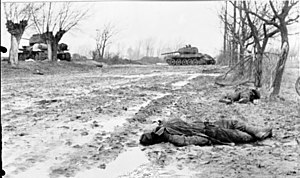Operation Sonnenwende
| Operation Solstice | |||||||
|---|---|---|---|---|---|---|---|
| Part of Eastern Front of World War II | |||||||
 Dead Soviet soldiers and destroyed tanks in southern Pomerania, 20 February 1945 |
|||||||
|
|||||||
| Belligerents | |||||||
|
|
|
||||||
| Commanders and leaders | |||||||
|
Walther Wenck Felix Steiner |
Georgy Zhukov | ||||||
| Strength | |||||||
| 7 panzer and Panzergrenadier divisions | 1st Belorussian Front | ||||||
Operation Solstice (German: Unternehmen Sonnenwende), also known as Unternehmen Husarenritt or the "Stargard tank battle", was one of the last German armoured offensive operations on the Eastern Front in World War II.
It was originally planned as a major offensive but was executed as a limited attack, due to limited planning by the Germans and from Soviet military intelligence. Intended to relieve the city of Küstrin, Sonnenwende was launched on 15 February 1945 from Stargard, Pomerania. By 18 February, the Soviet 1st Belorussian Front led by Georgy Zhukov had defeated the attack, prompting the Germans to call off the offensive. Despite its failure, the operation had forced Soviet High Command (Stavka) to postpone the planned attack on Berlin from February to April, focusing forces on the East Pomeranian Offensive, launched on 24 February and not concluded until 4 April.
The operation took place in response to the Soviet advance on Berlin in early 1945. Launched January 12, 1945, the Soviet Vistula-Oder Offensive had ripped open a gap hundreds of kilometers long in German defensive lines, and the Soviets had subsequently pushed from the Vistula River to the Oder River. As the Soviet advance to the west reached its farthest point, its apex narrowed, leaving long northern and southern flanks into which retreating German formations had moved and along which the Germans were attempting to reestablish a cohesive defensive line.
...
Wikipedia
